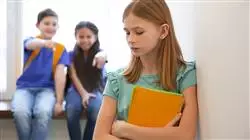University certificate
The world's largest faculty of psychology”
Introduction to the Program
Get ready to compete among the most valued professionals in the industry”

This program offers a comprehensive view of conflict resolution in the environment of minors, as well as successful models of approach, providing tools, experiences and advances in this field, which have also been guaranteed by the teaching staff of the Postgraduate certificate, as all of them work in this field. Each psychologist will learn, based on professional experience, as well as evidence-based pedagogy, which makes patient training more effective and accurate.
The skills that a mediator possesses are the same that the psychologist can cultivate, serving as a mediator between the student and the learning process; their intention would be to encourage and facilitate this process in order for the child to reach their goal. Mediation in the emerging socio-educational system, capable of strengthening both in all parties involved in the process a positive point of improvement so that the result is to allow both educational and human learning of the relationships that are established in this environment.
The perspective from the emerging psychological paradigm must be inclusive and must be based on a biopsychosocial model that contemplates attention to diversity from a comprehensive approach aimed at the entire educational community.
Psychologists, especially child psychologists, as well as related professions both in the educational and social-health fields, need to know the characteristics of these students, know how to identify their needs and have the knowledge and tools to intervene at a personal, socio-familial and, above all, educational level.
This Postgraduate certificate is a response to the demand for continuous training of professionals and is aimed primarily at child psychologists. With this action, the teacher will acquire skills to manage conflict situations in the child's environment and in the educational context, adjust the plans of attention to diversity and the educational projects of the centers, as well as to be able to design a mediation plan in the educational center.
TECH is not settled only with theory: it takes you to the most practical and competent know-how"
This Postgraduate certificate in Classroom Conflict Avoidance Techniques contains the most complete and up-to-date program on the market. The most important features include:
- The development of different practical cases presented by experts in Classroom Conflict Avoidance Techniques
- The graphic, schematic, and practical contents provide students with scientific and practical information on the disciplines that are essential for professional practice
- New developments on Classroom Conflict Avoidance Techniques
- Its practical exercises where to perform the self-assessment process to improve learning
- Its special emphasis on innovative methodologies in Classroom Conflict Avoidance Techniques
- Theoretical lessons, questions to the expert, debate forums on controversial topics, and individual reflection assignments
- Content that is accessible from any fixed or portable device with an internet connection
Complete your training with this Postgraduate certificate, which has the most innovative methodology in the market. You will be able to balance it with your work as it is 100% online”
It includes, in its teaching staff, professionals belonging to the field of Classroom Conflict Avoidance Techniques, who bring to this program the experience of their work, as well as recognized specialists belonging to reference societies and prestigious universities.
The multimedia content, developed with the latest educational technology, will provide the professional with situated and contextual learning, i.e., a simulated environment that will provide an immersive program designed to learn in real situations.
This program is designed around Problem-Based Learning, whereby the educators must try to solve the different professional practice situations that arise throughout the program. For this purpose, the educator will have the help of an innovative interactive video system developed by recognized experts in the field of Classroom Conflict Avoidance Techniques with extensive teaching experience.
Learn to make the child's environment a place of development and growth by managing the different contingencies with skill and success"

A practical, real-world program that will give you the tools you need to help your patients, center staff and families move forward from conflict in a positive and enriching way"
Syllabus
The contents of this program have been developed on the basis of two main principles: on the one hand, their timeliness and effectiveness, and on the other hand, the students' ability to quickly and efficiently integrate their learning. This combination allows psychologists to learn in a progressive and constant way, evolving from the first moment to the highest level of competence in this area of work. In this way, through this content, the psychologists will acquire the necessary skills that will help them to practice with greater guarantees of success within the profession.

A high-level teaching program that will allow you to apply new concepts and strategies from the very first moment thanks to its practical and contextual approach”
Module 1. Teacher's Educational Styles
1.1. Becoming Aware of My Educational Style
1.1.1. Starting by Knowing Oneself
1.1.2. Everyone Educates from their Own Backpack
1.1.3. On the Concept of Authority
1.1.4. Four Educational Styles/Approaches
1.2. Permissive Style
1.2.1. Characteristics of the Cooperative Style
1.2.2. Adult Characteristics
1.2.3. Some Ideas If You Follow this Style
1.2.4. Consequences of this Style with Children
1.3. Overprotective Style
1.3.1. Characteristics of the Cooperative Style
1.3.2. Adult Characteristics
1.3.3. Some Ideas If You Follow this Style
1.3.4. Consequences of this Style with Children
1.4. Authoritarian Style
1.4.1. Characteristics of the Authoritarian Style with Adults
1.4.2. Some Ideas If You Follow this Style
1.4.3. Consequences of this Style with Children
1.5. Cooperative Style
1.5.1. Characteristics of the Cooperative Style
1.5.2. Adult Characteristics
1.5.3. Some Ideas If You Follow this Style
1.5.4. Consequences of this Style with Children
1.6. How to Speak so that Children Listen
1.6.1. Speaking Mechanisms so that Children Listen
1.7. How to Listen so that Children Speak
1.7.1. Speaking Mechanisms so that Children Speak
1.8. Active Listening Based on Validation from Others
1.8.1. Listening through Behavior
1.8.2. Naming Feelings
1.8.3. Discovering Basic Needs
1.8.4. Time to Listen
1.8.5. Establishing Eye Contact
1.9. Steps to Modify the Behavior of My Students
1.9.1. Defining the Problem
1.9.2. Approaching Problems One at a Time
1.9.3. Being Consequential and Consistent
1.9.4. Being Positive
1.9.5. Letting the Child Know What is Expected of Them
1.10. Basic Disciplinary Techniques
1.10.1. How to Give Praise
1.10.2. How to Ignore
1.10.3. How to Reward
1.10.4. How to Reprimand
1.10.5. Time-Out Technique
1.10.6. Problem Chairs
1.10.7. How to Use Overcorrection
Module 2. Ways of Expressing Reached Agreements
2.1. Reaching Agreement
2.1.1. Consensus
2.1.2. Commitment
2.1.3. Voting
2.1.4. Postponing the Decision
2.1.5. Customizable Solution
2.1.6. Arbitration
2.1.7. Lateral Thinking
2.1.8. Plus Minus Interesting (PMI)
2.1.9. Decision-Making Matrix
2.1.10. Negotiation
2.2. Remember Your Goal
2.2.1. The Goal and How to Remember It
2.3. Listen to What the Other Person Is Telling You
2.3.1. Learning to Listen to Others
2.4. Speak for Yourself, Not for Others
2.4.1. How to Speak for Oneself
2.5. Do not Start on Another Melon until you Finish the One you are Eating
2.5.1. How to Finish One Thing Before Starting Another
2.6. Put on Someone Else’s Glasses
2.6.1. How to Put Yourself in the Other's Place
2.7. Choose the Right Moment to Tell Them
2.7.1. How to Find the Right Moment to Start a Conversation
2.8. Don't Take It Personally
2.8.1. Don’t Take Matters into Private Domains
2.9. Use the Sandwich Technique (Positive, Critical, Positive)
2.9.1. Definition of the Sandwich Technique
2.10. Express Yourself in Terms of: I Am Very Happy That You Have ...
2.10.1. Knowledge of Positive Terms

This training will allow you to advance your career in a comfortable way"
Postgraduate Certificate in Conflict Avoidance Techniques for the Classroom
If you are looking for training that will allow you to prevent and manage conflict situations in the school environment effectively, the Postgraduate Certificate in Conflict Avoidance Techniques in the Classroom is the ideal option for you. Through this TECH program, you will be able to acquire the skills and knowledge necessary to prevent and manage conflict situations that may arise in the school environment. Its curriculum is designed to offer you a comprehensive vision of conflict prevention, providing successful models and practical tools to avoid conflict situations in the classroom. In addition, the teachers who teach this Postgraduate Certificate have extensive experience in dealing with conflict situations in the school environment.
You will have a high-level teaching team.
This Postgraduate Certificate Course presents the best practices in conflict management in the classroom, based on experience and evidence-based pedagogy. In this way, you will be able to train in the adjustment of the plans of attention to diversity and educational projects, as well as to design a mediation plan in the educational center. All this, through a 100% online platform, which you can access anytime, anywhere.







